Reef Knot (Square Knot) - The reef knot is useful for Sail ties when reefing or furling the Sail.

[Top]
Round Turn and two Half Hitches - This knot can be used almost any time you want to tie something to something else. It is often used to tie fenders to a stanchion or lifeline. Although it won't keep a line from slipping on a spar it stay tied even when jiggled.
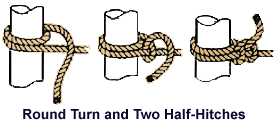
[Top]
Bowline - The bowline, called the king of knots, is used to tie an eye onto the end on a line. It is used for attaching the jib sheets to the jib, for mooring boats and for fastening outhauls, centerboard pennants, etc., to holes and pins. A correctly made bowline is very secure, yet easy to untie.
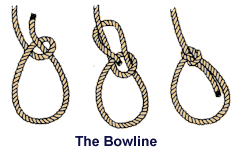
[Top]
Figure Eight Knot - This knot is useful as a stopper knot, used to keep jib sheets and other lines from pulling out of their leads. Do not use a simple overhand knot for this purpose. It becomes hard to remove. Figure eights are more easily removed.

[Top]
Clove Hitch - The clove hitch is good for tying lines around solid objects like a post, mast, etc. One use is in tying the tiller up to the main sheet. It may come undone if jiggled.
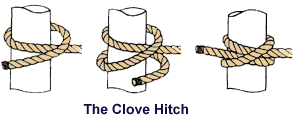
[Top]
Sheet Bend - The sheet bend is used to tie two lines together, end to end. It is meant to be used when the lines are about the same size. If lines are very different or are slippery a double sheet bend is recommended.
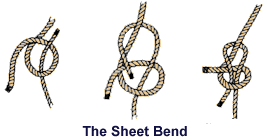
[Top]
Cleat Hitch - The cleat hitch is the way a line is secured to a deck cleat.Cleats are used for securing lines. To fasten a line on a cleat, make a full turn around the base, then two or three figure eight turns. For extra security, finish with a half hitch.
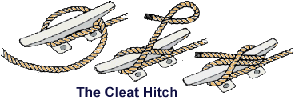
[Top]
| Contents | 1 | 2 | 3 | 4 | 5 | 6 | 7 | 8 | 9 | 10 | 11 | 12 | 13 | 14 | 15 | 16 | 17 | 18 | 19 |
[Previous Chapter] [Next Chapter]